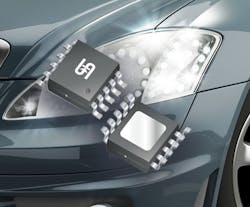Taiwan Semiconductor Corporation (TSC) has announced an LED driver IC targeting automotive solid-state lighting (SSL) applications for virtually all exterior functions from headlamps to dynamic indicators. Diodes Inc has announced new PNP transistors for switching current in LED matrix implementations for various exterior automotive lighting. Moving into the auto cabin, Inova Semiconductors has announced an LED driver/controller IC for dynamic RGB (red, green, blue) color presentations for ambience and safety and compatibility with the ISELED standard.
Driver IC
The TSC driver IC was developed with the idea that product developers could base all of the exterior automotive lighting functions around the same IC via a very configurable architecture. The requirements for, say, headlamps might be very different in terms of drive current and modulation scheme relative to perhaps a turn indicator. But the flexibility of the TS19501 driver IC allows the developer to adapt it to all challenges and the development and purchasing teams to streamline product designs and inventory management.
“The lighting market including automotive lighting is moving toward replacing halogen and incandescent lighting with high-efficiency LEDs,” said Sam Wang, vice president of TSC. “The need for highly integrated LED drivers which save assembly time and cost and afford designers maximum design flexibility is critical as electrification of transportation continues.”
The new driver IC can enable circuit designs based on boost, buck-boost, and SEPIC (single-ended primary inductance converter) topologies. Moreover, the driver can utilize a choice of DCM (discontinuous conduction mode), BCM (boundary conduction mode), or CCM (continuous conduction mode) operating modes. A spread spectrum clock can help ensure that designs meet EMI/RFI noise emission limits. And the IC supports PWM (pulsewidth modulation) and analog dimming.
TSC said that the exterior lighting market is moving toward far more complex designs for headlamps and indicator lights, truly leveraging the capabilities of the tiny LED form factor and the option of connecting LEDs in strings to deliver dynamic effects. The TSC driver IC meets the auto industry AEC-Q100 standard for electronics operating reliably in the harsh automotive environment.
Matrix switching
Moving to the Diodes news, the company announced the ZXTP56060FDBQ and ZXTP56020FDBQ dual PNP transistors for matrix lighting. We first heard the term matrix relative to automotive lighting back in 2013 when Audi announced its Matrix headlamps. The design used arrays of LEDs and what came to be known as adaptive drive-beam technology to steer headlamp beams following corners, for example, and ensuring that oncoming drivers were never blinded. Since that time, we have covered the design of matrix headlamps a number of times.
The Diodes pitch includes headlamps within the target application but goes further. The company said that even functions such as turn indicators are moving to matrix designs to enable animations. Broader usage of matrix technology will require a more diverse selection of current-switching transistors and thus the new offering. As in the TSC case, the new Diodes products are AEC-Q100 qualified.
RGB cabin lighting
For in-cabin lighting, we have followed developments associated with the ISELED Alliance going back several years since Inova drove the establishment of the organization. When we last reported on the membership a year back, there were 22 members supporting the two-wire digital bus that can control and power LED strings including light engines that mix RGB components. The standard will simplify the development of more compelling ambient lighting schemes.
The new Inova INLC10AQ IC is available as a bare die for integration directly on modular light engine substrates or flex circuits, or as a packaged IC for ease of handling and installation. Product developers will be able to daisy chain as many as 4079 of the controllers and connected LED strings on a single 2-Mbps bus. Such an interior lighting subsystem could be easily controlled by a single microcontroller. As the model number perhaps implies, the IC is AEC-Q100 qualified.
For up-to-the-minute LED and SSL updates, why not follow us on Twitter? You’ll find curated content and commentary, as well as information on industry events, webcasts, and surveys on our LinkedIn Company Page and our Facebook page.





